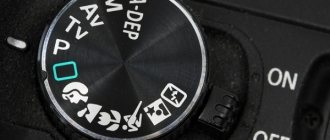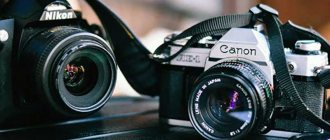Remember the song from the popular TV show? “I always take a video camera with me...” Nowadays it’s not difficult to film a video, even if you don’t have a special camera. Modern smartphones shoot excellent quality videos. But once upon a time, the appearance of the first video cameras became a discovery in the world of technology.
First, in 1891, the movie camera was created. It was a primitive mechanism: a gear wheel spun the film so that the frame was opposite the lens, and a shutter (a device for blocking the light flux) regulated the light falling on the film. The device was created by an American of Scottish origin, William Dixon. Kinetograph - that’s what this miracle device was called in those days. Dixon also created the first film: according to the plot, the person in the frame bowed and sneezed. Naturally, this is nothing special for us, but then the lucky ones who saw these shots were shocked.
First movie camera 1891
And the very first mechanical television camera was designed by test engineer John Baird, Dixon's compatriot, in 1924. The principle of operation of this pioneer device was the use of a Nipkow disk. This mechanical device is a simple rotating disk of opaque material, which has a number of holes of the same diameter and at the same distance from each other.
First camera
More recently, photographs were black and white, and the cameras themselves were significantly different from those that exist now.
In 1826, Joseph Niepce presented to the public his invention - the camera. The “picture” was preserved in it through complex chemical reactions. Glass, asphalt-based varnish, and other similar substances and compositions were used. The photographer did not think for long about what the first photograph would be. Looking outside, he noticed several funny things. Pointing the world's first lens out of a window, he captured what he saw. By the way, this photo is still available for viewing today.
The following year, the inventor began a collaboration with the artist Jacques Mandé Daguerre. With it, the camera was improved, and the picture was first taken in 20 minutes, and then in seconds.
The photographs taken with the first camera were of poor quality, so improvements continued. Already in 1835, physicist William Talbot was able to achieve clarity in photographs, which was the beginning of the photographic industry.
Mass production of cameras
The first mass-produced SLR cameras appeared in 1924. These were small-sized cameras manufactured by the Leitz Company, which were produced under the Leica brand and gained enormous popularity throughout the world. The film they used was regular 35mm cinematographic film. In 1935, after many years of improvements, Kodak created the world's first color film based on the invention of the Lumière brothers and launched it into wide production. Its improved version, Kodakcolor, which the company introduced in 1945, was produced virtually unchanged until the 90s, when film was replaced by digital.
Daguerreotype
The daguerreotype is the first photograph in history that resembles a mirror monochrome image.
The first daggerotype was made by Louis Daguerre in 1837, showing his workshop. The daguerreotype process was very labor-intensive, and the development of photographs took a long time, but this method lasted 20 years. It was based on the light sensitivity of silver iodide. A silver plated copper plate was used. Subsequently, this method was replaced by more advanced devices.
Pinhole camera
Even before the invention of photography, people were familiar with the principles on which it was ultimately based. They could create images on a wall or a piece of paper, but photographic printing was not possible at the time because storing a light image proved more difficult than projecting it. The tool used to work with images was called a camera obscura (which means “dark room” in Latin) and it existed several centuries before the advent of photography.
It is believed that the camera obscura was invented around the 13th-14th centuries, but the chronicle of the Arab scientist Hasan ibn Hasan, 10th century, describes the principles of the camera obscura, on which analogue photography was eventually based.
A camera obscura is essentially a dark, closed box with a hole in one of the walls. The hole must be small enough relative to the size of the box for the pinhole camera to work properly. The principle of its operation is based on the laws of optics: light passing through a tiny hole is transformed and creates an image on the encountered surface, which is the wall of the box. The image was mirrored and reversed, but a modern analog camera works in much the same way, differing only in the presence of a mirror and film to preserve the image created by the light.
Photography, and the very method of its creation, has always been called the killer of fine art. However, it is believed that the principles of photography were widely used by Renaissance artists - Leonardo Da Vinci, Michelangelo and others. In the mid-16th century, Italian scientist Giovanni Battista della Porta wrote an essay about how a camera obscura could be used to make drawing easier. He projected an image of people standing outside a camera obscura onto a canvas inside it (the camera obscura in this case was a large room) and then painted or copied the resulting image.
The process of using a camera obscura seemed very strange and frightening to people in those distant times and Giovanni Battista was forced to abandon his idea after he was arrested on charges of witchcraft.
The drawing depicts working in a camera obscura as it looked at that time.
Although only a few Renaissance artists admitted to using camera obscura, it is believed that the majority used them. The reason for not admitting this openly was the fear of being accused of the occult, or simply a reluctance to admit to what many artists considered to be some kind of deception.
Today we can state that the camera obscura was the prototype of the modern camera. Even though it seems unnecessary today, many people still find it entertaining and use it for art purposes or just for fun. Installing the film and capturing the image was a logical progression.
If you want to create a camera obscura, you can find a lot of examples and tips on how to do this on the Internet.
Mirrors
In 1861, a camera with a reflex lens was created. What it was: a large box with a lid, which was attached to a tripod. Observation was carried out through the lid, but light could not be allowed to penetrate. First, the lens found focus on the glass, then the image was formed using mirrors.
And in 1950, the SLR camera was already created. A person could see in the viewfinder what the lens sees. This effect was created by refracting light from a mirror into the viewfinder. This camera has finally gained popularity among ordinary people who have not been professionally trained in photography. The mirror did not affect the quality of the photograph, but was considered an important auxiliary part in creating a photo.
The beginning of the era of photography. Kodak camera - the very first roll film camera
The further development of photography was influenced by photographic films. This happened in 1889. American entrepreneur and inventor George Eastman receives a patent for roll film and, somewhat later, a Kodak camera. This camera was invented specifically for working with film in rolls. Today, Kodak is still one of the leading manufacturers of photographic equipment.
Digital photography
In December 1975, the first digital camera was invented, weighing 3.5 kg. It included dozens of circuit boards and a cassette player. The camera ran on 16 nickel-cadmium batteries. It was made by Steve Sasson, who worked as an engineer at Kodak. The image was taken in 23 seconds and saved onto a magnetic cassette. This project marked the beginning of digital photography. Subsequently, improvements were made to make the camera more convenient and accessible to a mass audience.
Nowadays we take photographs without much difficulty. Every phone has this feature - you just need to make one or two movements. It is already difficult to imagine what life would be like without photography. Smile!…
Cameras in the USSR
In the USSR, the development of cameras was on par with Western countries. The first Soviet cameras were produced back in 1929; these were large-format folding plate cameras EFTE, developed by the Moscow artel Fototrud. But they were produced in too small a series, literally dozens of units, so they were not widely used. But the Photokor 1 camera, developed by the Leningrad Optical-Mechanical Plant in 1930, became truly large-scale. Over eleven years of production, more than one million units were produced, which were widely used in all areas. In addition, in 1934-35, three more models of popular Soviet cameras were produced: a folding scale Tourist with a central shutter and a 65x90 mm frame, a small-format SLR Sport with a curtain shutter, and a copy of the German Leica II camera, which in the USSR was called FED. By the way, the Sport was a completely original development, which may well compete with the German Kine Exakta SLR for the title of the world's first single-lens SLR camera shooting on 35 mm film. In the pre-war years, simple amateur cameras became widespread and were used in school amateur photography clubs and by ordinary citizens. These cameras, called Lilliput, Student and Baby, were freely sold in stores at a very affordable price, were easy to learn, so anyone could use them. In the post-war years, the development of photography in the USSR proceeded quite vigorously, although in the 1980s it began to lag behind the West, where fierce competition in the market played its beneficial role. Models such as Zorkiy, Zenit, Moscow, Kyiv, Smena, FED and others were, for the most part, completely independent developments.
Leaders in photo production
In the late 1980s and early 1990s, the popularity of Soviet cameras quickly faded away, as more advanced models from Canon, Kodak, Sony , Nikon and Leica appeared on the market, which were superior to their domestic counterparts in all respects. Digital instead of film Already in the mid-1970s, almost all photographic equipment manufacturers were simultaneously developing developments to save the resulting image not on photosensitive material, but on digital media. The first developments were presented back in 1981 by Sony. But the first digital cameras that were mass-produced and offered for sale were released by Fuji in 1988, its model DS-1P saved the resulting image to a SPAM card. In the same year, the first digital SLR appeared, it was the Electro-Optic-Camera model from Kodak. Since then, in a very short time, bulky and extremely expensive (the price of the first models started at $1000) digital cameras have very quickly evolved to small-sized, convenient and quite inexpensive models that everyone can afford.
{img1}
The history of the camera
Nowadays, there are many models of cameras that help a person take pictures of very high quality. Every year, more and more new models are released that are equipped with various functions. But probably every family has old black and white photographs that remind them of significant events. Unfortunately, few people know the history of the creation of the camera. The first device was released about two hundred years ago, and the invention created a real sensation. But no one at that time could even imagine that this invention would soon be improved and become so popular. The first camera An astronomer named Johannes Kepler in the 17th century put into practice the laws that spoke about the refraction of light. This made it possible to project any image onto the surface of the wall. But for the first time the image was recorded only in 1820, it was made by Joseph Nicéphore Niepce. He used asphalt varnish to fix it. It was this installation that was called the first camera; the design of the device was very complex. After the invention of such a camera, William Talbot began to use it. This scientist used a camera to take a negative and make the resulting image a little better. Already in 1865, T. Sutton invented a mirror lens. This was one of the most important events in the history of the camera. Using this device it was already possible to take fairly good photographs with high quality. The invention of photographic film Another important event in the history of the camera was the advent of Kodak photographic film. Film was invented in 1889. And just five years later - in 1904 - a special plate for making color photography was invented. These plates were invented by the Lumiere brothers. This was a real breakthrough in the history of the camera. The invention of color photographs But it was not only the Lumière brothers who carried out experiments and research. There lived an excellent photographer in Russia who patented several new technologies. This photographer's name was S. M. Prokudin-Gorsky. After using these technologies, people were able to take the first color photographs. The first camera company was Leica. The first mass production of these products began in 1925. 35 mm film was used for this camera. The negatives were very small, but photographs from them could be made quite large. It was a real miracle for people. These cameras were produced under the Leica brand. It was these products that were purchased most often, and for a long time they were top sellers around the world. It was this company that used focusing and delay for the camera, this helped to take clearer and higher-quality photographs. Later, cameras from Polaroid went on sale. Immediately after the shooting, the photograph was printed; people undoubtedly liked this very much, and they began to buy these products. This event occurred in 1963. And after that, developers began to add all sorts of functions to the camera and make it more modern. This product has become more functional, with various additions. After some time, the first digital camera was released. A photograph of the starry sky was taken using a camera; this happened in 1974. And in 1980, manufacturers began selling digital video cameras. Now every person is familiar with this thing and knows how to use it. Nowadays, cameras are built into various office equipment; devices are improved every year. Nowadays, there are many camera companies, here are some of the most popular brands: 1) Nikon;
2) Canon; 3) Samsung; 4) Sony. The history of the creation of the camera is quite interesting, but not very long. Humanity only needed to spend 150 years to create the ideal camera that would help remember all the important events in a person’s life. Nowadays, many people make money using a camera. They work as photo reporters and photograph wedding celebrations or birthdays. Additional Information
| Manufacturer country | — |
| Manufacturer | — |
| Importer | — |
| Warranty period, months | — |
| Service life, months | — |
| Manufacturer's warranty | — |
| Representative, repair organization | — |











